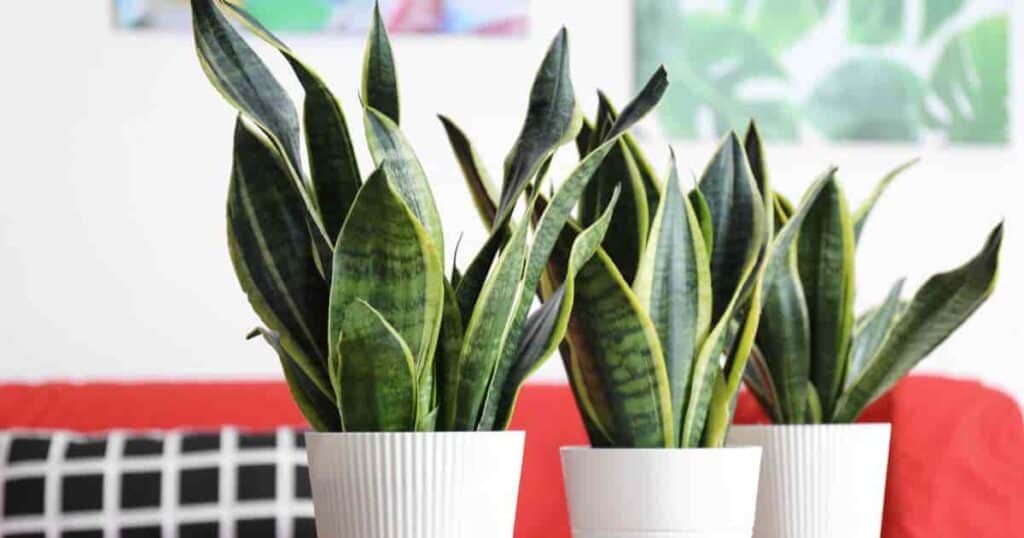Easy care Snake Plants (Sansevieria and now Dracaena) tend to survive and thrive no matter what you do to them; however, even these easy growers have preferences regarding light, water, soil, and pots.
As with all plants, you must have good drainage and air circulation to avoid problems with root rot. For this reason, pots made of natural materials, such as terra cotta or wood, are preferable.

No matter the material, your pot must have drain holes, and you must not overwater. Pot your Snake Plant using a light mixture amended with coarse sand or perlite (or pick a succulent or cactus mix).
Use a soak-and-dry watering method, and never allow your plant to stand in water.
Divide Your Sansevieria At Repotting Time
Snake Plants reproduce rapidly through runners. More often than not, repotting is necessitated by the parent plant filling the pot with offspring (pups).
Therefore, when you repot, you should separate these snake plant pups from the parent and give them their own well-draining pots.
The presenter of this video chose to replant the parent plant and multiple pups as one plant; however, she could easily have divided these and ended up with half a dozen or more independent plants.
Repotting A Snake Plant
The presenter chose a tall plastic pot with lots of drainage slots in the bottom. This will be alright as long as she doesn’t overwater.
Generally speaking, Snake plants do better in a natural material, such as terra cotta or wood, allowing excellent drainage and air circulation to the roots.
A shallower pot with lots of soil surface area also allows better air circulation and more space for pups to spread.
Can You Plant Sansevieria in the Landscape?
Fast-growing, rugged Sansevieria are native to southern Asia, Madagascar, and Africa. They can do well planted in the landscape as an annual in areas that experience cold winters.
Snake plants growing outdoors spread by runners during the growing season. They do very well in an outdoor planter or sheltered garden bed that receives bright, indirect sunlight.
If you plant it this way, you can dig up a few runners at the end of the growing season to keep indoors as houseplants through the winter.
In a desert or tropical setting (USDA hardiness zones 9 to 11), you must be very careful about planting Snake Plant outdoors.
It can quickly become invasive if it can live through the winter. Unfortunately, it has done that in Florida, where two varieties (Sansevieria trifasciata and Sansevieria hyacinthoides) present a very high risk of invasion.
It’s worth noting that other Sansevieria varieties are not considered invasive (70 all-told).
Even so, you should control this plant if planting it outdoors in an area with temperate winters. Keep it in an enclosed planter or raised bed with very dense underlining.
How Do You Most Successfully Pot A Snake Plant?
Here are the steps to follow when potting a snake plant:
- Choose a wide, shallow terra-cotta container with ample drainage holes.
- Use a light, airy potting mix. You can purchase an especially formulated cactus or succulent mix or use a high-quality standard potting mix and lighten it with a bit of coarse sand or perlite.
- Fill your container about two-thirds of the way full with your potting mixture. Make a well in the center of the potting mixture.
- Remove your plant from its current pot. If you’ve just purchased it from a store, it may still be loose in its pot and easy to remove. However, if it’s been in the pot for a while and has filled it with roots and pups, you may have a bit of a challenge.
- Loosen it by tapping the sides of the pot and sliding a knife blade or trowel between the inside and root mass. You don’t have to be especially gentle, but don’t pull the plant out by its vegetation. This could be damaging.
- If you encounter a mass of roots and pups, separate them with your fingers and with a sharp, clean-cutting implement.
- Choose your favorite to put in the prepared pot and set the others aside. If you don’t have enough containers and soil for the plant’s offspring, they will be fine for a day or so simply placed in a sheltered setting while you gather your materials or find them new homes.
- Add more soil to your prepared pot to surround and support your chosen Snake Plant.
- Cover the plant’s roots and firm the soil down with your hands. Leave about an inch of space between the top of the soil and the lip of the container.
- Give the soil a gentle soaking, allowing water to run through the soil and out the drainage holes. Don’t leave the plant sitting in water.
- Put your freshly potted Sansevieria in a sheltered location that consistently stays warm and receives bright, indirect sunlight.
- Don’t water again until the soil is relatively dry. Then provide another thorough watering. Maintain this soak-and-dry watering method.
Create Interesting Planter Combinations With Snake Plant
As described above, your Sansevieria will quickly spread and fill your wide, shallow planter, but you don’t have to plant Snake Plant on its own.
It makes a lovely companion for various other plants with similar requirements. Examples include cacti and succulents.
Air plants can also be artfully placed among these combinations, as long as you provide a little pedestal of stones to prevent the air plant from touching the soil.
This tropical plant thrives in bright, indirect sunlight with regular soak-and-dry watering.
While it can do well in low light, it will do better with brighter light so that it can be creatively paired with many plants with similar preferences.
This kind of creative planting combination adds a lot of visual interest with a minimal amount of care and maintenance.
